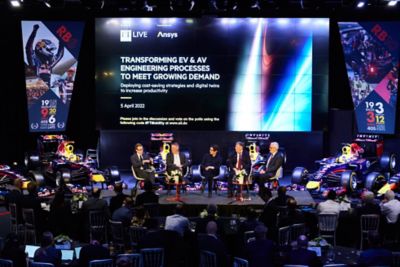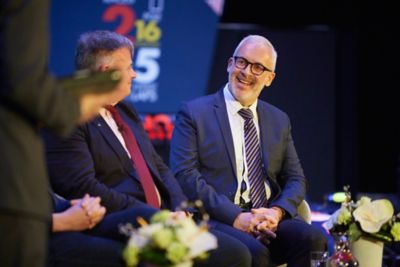-
United States -
United Kingdom -
India -
France -
Deutschland -
Italia -
日本 -
대한민국 -
中国 -
台灣
-
Ansys는 학생들에게 시뮬레이션 엔지니어링 소프트웨어를 무료로 제공함으로써 오늘날의 학생들의 성장을 지속적으로 지원하고 있습니다.
-
Ansys는 학생들에게 시뮬레이션 엔지니어링 소프트웨어를 무료로 제공함으로써 오늘날의 학생들의 성장을 지속적으로 지원하고 있습니다.
-
Ansys는 학생들에게 시뮬레이션 엔지니어링 소프트웨어를 무료로 제공함으로써 오늘날의 학생들의 성장을 지속적으로 지원하고 있습니다.
ANSYS BLOG
April 22, 2022
Transforming Electric Vehicle and Autonomous Vehicle Engineering Processes to Meet Growing Demand
The mobility industry is on the cusp of enormous change, from connectivity and electrification to the rise of autonomous vehicles (AVs). Whether it’s considering electric vehicles (EVs) or passenger buses, complex engineering challenges persist with physics, fluids, and thermal management all dependent on each other. Ansys’ comprehensive software solutions and resources can develop and deliver simulation at scale for the full product cycle. These solutions accelerate innovation and trends to help facilitate the effort the engineering community is facing with shrinking development processes. Enhancing digital capabilities through simulation increases business agility, accelerating progress in fast-moving markets to deliver more innovative solutions.
On April 5 2022, Ansys examined these topics at our hybrid panel event, which was held in partnership with Financial Times and hosted by our Innovation Partner Oracle Red Bull Racing at their Technology Campus in Milton Keynes, UK. Moderated by Peter Campbell, Global Motor Industry correspondent at the Financial Times, several industry experts explored the transformation of EV and AV engineering processes to meet growing demand.

How Simulation Can Accelerate Mobility Super Trends
As we strive to comply with global legislative pressures around internal combustion engine (ICE) vehicles and reaching sustainability targets, solutions that assist engineers and shorten lead and development times will be vital to success. Traditional testing approaches will simply not work with shortening production cycles and rates of adoption of EVs and autonomous vehicles, which are being developed faster than standard practices. Learning from other industries and sectors that are further along in their electrification can be hugely beneficial, such as the bus sector, where valuable lessons exist on how they have aided rapid innovation and cost-saving strategies. How will vehicles be developed and engineered in the next 5 to ten years?
“Trying to anticipate and reduce the amount of physical prototyping to the minimum — it is not just a question of budget for prototypes, but also the general feasibility, especially with EVs and AVs,” Bianchi says. “We can predict the way these products will behave in all different conditions, and virtual representations of products using simulation is key.”
Ansys offers a range of simulation solutions, including the ability to create simulation-based digital twins that can provide greater visibility over all engineering processes. This allows the mobility industry to match cycle times to the pace of technology.

Panelists at the event included (from left to right): Chris Gall, Group Engineering Director, Alexander Dennis; Daniel Smith, Aerodynamics Group Leader, Red Bull Technology; Stuart Bradley, Head of Power Electronics, Machine and Drives, Ricardo; and Dr. Christophe Bianchi, Director of Business Strategy, Ansys.
Keeping Up With the Future of Electrification: Polling Industry Experts
As the world shifts towards EVs and computing power increases, how can vehicles be brought to market quicker and be more up to date? It is a question on the top of many organizations’ agendas as we accelerate towards greater digital transformation efforts and demands across every industry to be data driven. Audience members were polled on several topics, with one question being “How we can look at expanding battery operating life?” In this instance, “smart” power management with artificial intelligence (AI) on the edge received just under half the vote as the key determining factor (48%), with use of digital twins for predictive maintenance (29%) and bespoke car charging with artificial power stations (24%) also being top priorities. Software-defined cars are leading the way, and as data-driven engineering and the connected car becomes more complex, simulation can unpack this complexity. Optimizing design and testing data after digital versions of products are created is vital for accelerating innovation efforts. By using methods such as machine learning, systems can learn from data patterns and make decisions with minimal human intervention, gaining momentum in a fast-moving sector.
The Race to Sustainability
From material choices and electrification to the proposed recyclability of batteries, companies are increasingly pursuing engineering programs for sustainable product development. Bianchi discussed this during the session.
“Material intelligence is about fatigue, performance, and now a key element is sustainability,” Bianchi says. “How can a material be recycled, and not only that — how is it produced? From Formula 1 cars to road cars, the weight of batteries and units is a huge factor. Actors in the supply chain can use simulation to broaden their design space.”
Our poll found 73% of respondents placing electrification and alternate fuel as a key program their company is pursuing. Given these results, demand is certainly there. Manufacturers, suppliers, and partners must continuously innovate and improve solutions as new models get updated, as well as develop standards for simulation loops. Optimizing data from simulations and digital twins can engage these capabilities with greater accuracy and speed.
A changing landscape requires a lasting shift for automakers to think outside the box and create solutions to strive towards an innovative future on the roads.
Interested in learning more? Click here to view a recording of the panel event, now available on demand until May 5.
Next on the watchlist? Bianchi and Campbell will be discussing the importance of virtual prototyping in “Winning the Race to Net Zero with Virtual Prototyping” at Future of the Car 2022, a London-based hybrid event taking place in May. To register, click here.











